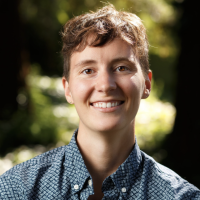GTC Graduate Teaching Community Reflections
Fall 2021
Introduction
Members of the Graduate Teaching Community reflected on the following prompt at the conclusion of the Fall 2021 quarter: How has reading and discussing Relationship-Rich Education by Peter Felten and Leo M. Lambert impacted your thinking about the role of relationships in the classroom?
Chloe Karaskiewicz, Psychology

Reading and discussing Relationship-Rich Education was incredibly thought provoking, especially as I prepare to teach my own course in-person for the first time. The authors make a compelling case for the benefits of fostering campus relationships for students and emphasize how these relationships can be supported by individuals, departments, and educational institutions. While students benefit academically from fostering these relationships, they are also more likely to enjoy their collegiate experience and report a stronger sense of belonging within academia. As I prepare to welcome students to my own classroom next quarter, I am excited to incorporate strategies derived from case studies within the text and through discussion with my peers. For example, I am looking forward to getting to know my students more deeply, especially their motivation for enrolling in my course, so that I can tailor the material to their interests and needs. Following a group discussion on how to promote deeper learning, I also intend to expand the critical thinking aspect of my course to challenge students to relate what we are learning in class to current events, another course they are taking, or their own lives.
Discussions of this text within the GTC challenged me to reflect on my own experiences as a learner as well as my own teaching and mentoring style. As a group we considered our own strengths (and areas for growth) and how to equitably evaluate the contributions of students who engage with class in different ways. For example, if we reward in-class participation, are we equitably allowing the contributions of introverted students to shine? As an instructor who employs a great deal of small group work in their class, this prompted me to re-design some of my assignments to emphasize that each student contributes unique perspectives and strengths to the group’s dynamic and deliverable final product. My new rubric and peer-evaluation form now reflect ways for students to make different contributions, rather than constraining each student to a similar role.
One aspect of the text that I found particularly insightful was the emphasis on how meaningful relationships can attenuate the challenges faced by first generation students. As someone who does not share this identity and the associated lived-experiences, reading testimonials and case-studies about the impact of relationships on educational attainment and satisfaction was incredibly important. For first generation students, close relationships with instructors and TAs can provide help in reframing challenges and navigating academia. Instructors can make seemingly small, but substantive changes to make their classrooms more equitable to students—such as explaining how to use office hours, constructing clear rubrics for assignments, and communicating expectations for coursework. This quarter’s reading and discussions have inspired me to work diligently on making my class material and assignments accessible for all of my students.
Christine Smudde, Materials Science and Engineering

Human connections drive success in education by cultivating an environment of vulnerability, curiosity, and improvement. However, making these connections a priority requires a cultural shift and a lifelong commitment from faculty, staff, and students that is currently lacking in college level education. Reading and discussing Relationship-Rich Education by Peter Felten and Leo M. Lambert with the Graduate Teaching Community (GTC) has greatly expanded my understanding of the challenges and requirements of effective education. So often young adults pass through college in a cloak of anonymity. They are caught up in the grades and resume boosting activities, which they believe are necessary. These students miss out on the connections and interactions that are known to enhance learning, belonging, and success in college.
The role of relationships in the classroom is not a topic I had spent much time philosophizing before this quarter with the GTC. However, once the topic had arisen, and I had time to reflect on my own personal experiences in the classroom, I realized that my life was guided by professors who encouraged relationships in the classroom and were committed to student success. I am a materials scientist because a professor from my freshman year of my undergraduate education made a large lecture class seem personal and fun. He also had lunch with me in the dining hall so I could ask him more about the possibilities of a career in materials science. I also attended many office hours to ask questions on the homework and lectures that I had a difficult time answering and understanding on my own. My experiences demonstrate an example of the powerful evidence that there are professors and staff already in existence who prioritize and are committed to student success through relationship-rich education. However, not all students have the same experiences or are exposed to the same opportunities for connections.
Reading and reflecting with the GTC has inspired me and motivated me to dedicate my pedagogy to maintaining and cultivating relationships and connections for student success. In my future work with undergraduate students, I plan to focus on their connections in the classroom with each other and myself. The discussions we had this quarter with the GTC brought up many ways to incorporate a relationship-rich philosophy for effective education. Some of the key takeaways, which I plan to use in the future, include student hours in a mutual space, clear communication of expectations through detailed syllabuses, and activities that will encourage help seeking behaviors in students. I will not allow those who enter my classroom pass through in their cloak of anonymity. By learning and understanding who they are as young adults, hopefully I can help them learn a little more about themselves and assist them in their journey to success.
Eli Moore, Applied Mathematics

After stumbling upon the GTC mid-quarter, I read chapters 3-6 of Relationship-Rich Education and have plans to go back and read chapters 1-2 this winter break, as this book manages to concisely develop practices that I have unintentionally used in my own education and teaching. One example of this is creating an inclusive classroom environment that ensures students are comfortable sharing their experiences, making mistakes, and asking questions. Another is focusing on developing student confidence in leadership and subject expertise enough to mentor each other. Largely speaking, much of my own academic confidence growth has come from informal discussions I had with my peers and mentors over the years, but this gain attributed to “relationships” was not as apparent to me before reading this book. Seeing these practices backed by research appeals to the evidence-based scientist within me, as it’s exciting to relate one’s lived anecdotes to observed large-scale phenomena!
I have always made it a point to humanize myself in the classroom, as I have found empathy and relatability to be some of the most desirable traits a Professor could have in my time as a student (in terms of keeping me engaged and accountable). As a student, I often found myself giving genuine effort toward learning when I could sense that the instructor perceived their students’ struggles to be material, as opposed to when instructors were condescending or belittling (which would often lead me to care more about the grade of the course, rather than my own learning). In my experience, students often look at their instructor’s mathematical abilities and see them as unattainable, as if these instructors didn’t also struggle with dropping minus signs or forgetting trig identities. This isn’t so surprising, since many instructors try to minimize their own mistakes during teaching so as to maintain a sense of control and authority over the classroom (well, this is at least noticeably true in math classes). Personally, I have found that control and authority do not contribute to an optimal learning environment, and they often create an unnecessary schism between students and instructors that does the opposite of forming a pro-learning relationship! With this in mind, highlighting my dropped minus signs during instruction humanizes my mathematical abilities, but it doesn’t build the same trust as consciously learning students’ names or meeting with them one-on-one, as chapter 4 mentions. These subject-agnostic practices go a long way toward developing accountability and a desire to learn within students, and seeing how they align with my general mindset of humanizing myself to create an inclusive classroom motivates me to include them in my own teaching.
The text also discusses ways to empower students to lead, mentor, and teach each other in chapters 5 and 6. Two of the most salient concepts that have been on my mind were First-year Interest Groups (FIGs) and fostering peer-to-peer interactions. I first heard of FIGs when Chloe mentioned them in her chapter 4 presentation, thought they were a great idea (as they have virtually no cost of implementation and develop a sense of community based on common interests), and was subsequently delighted to see them as a topic in chapter 5. When I find myself on service committees in my career, I will definitely be looking for ways to implement variants of this idea. During the chapter 5 discussion, we also talked about facilitating peer-to-peer teaching and discussion, and Hannah’s mention of Jigsaw activities jived well with my beliefs about empowering students and giving them confidence to discuss ideas collectively. To boot, I think this is exactly the type of “traditionally K-12 activity” that has its place in the college math classroom, as there are often a handful of topics or applications to be explored during a single lesson, and giving students the time to prepare a level of expertise before going to explain it to their peers seems like it should do wonders for their confidence in their ability to explain the concepts.
Hannah Nelson, Population Biology

There is an old adage, “you never realize the value of something until it is gone.” The pandemic showed me the value of relationships in education. Sure, most of us created some semblance of community for our students by fumbling through Zoom breakout room activities and online discussion boards, but there was still a deep sense of relational loss. Weeks of quarantine and emergency remote instruction left us starved for sustained, authentic relationships.
So with this hunger for human connection and the return to in-person instruction, I was delighted to dive into Peter Felten and Leo Lambert’s book Relationship-Rich Education with the Graduate Teaching Community this quarter. Drawing on nearly 400 interviews with students, faculty, and staff across a variety of higher education institutions and contexts, Felton and Lambert’s book offers practical advice for how to develop and sustain powerful relationship-rich learning.
While much of this book was a confirmation of my current philosophy and approaches to relationships in the classroom (e.g., learn student names, connect students to campus resources, carve out time in class to intentionally build relationships), there were five strategies that stood out to me as particularly innovative:
- Start every conversation with a student by asking, “How are things going?” This idea is probably not revolutionary to most instructors, but I realized in my own office hours, too often I start with, “How can I help you?” and only sometimes remember to engage more personally with students later in the conversation. At Brown University, writing tutors are trained to ask, “How are you doing?” at the beginning of every consultation session and then pause to listen to the consultee, even if it has nothing to do with writing. I love this strategy because it is so easy to implement and clearly humanizing.
- Rebrand office hours as “student hours” and offer them in a more familiar space. Renaming office hours as “student hours” clarifies their purpose to students by addressing the misconception that office hours are a time for faculty to get work done in their office. Shaun Vecera, a professor at the University of Iowa, found that moving his office hours to a residence hall increased the quantity of students who attended and the quality of their interactions. I am excited to experiment with “student hours” in a campus coffee shop or sunny spot on the quad in the future.
- Meet one-on-one with all of your students for a 10-15 minute conservation. Faculty involved in the Persistence Project, at Oakton Community College, develop pedagogical plans that include meeting one-on-one with each of their students for 10-15 minutes during the first couple weeks of the semester. While this strategy is time-consuming and may not be feasible for large classes, the students and faculty involved in this project described these meetings as transformational and accompanied by significant gains in student engagement and motivation.
- Offer students an opportunity to retake tests/quizzes in your office. This strategy comes from Serge Ballif, who is a faculty member at Nevada State College. In Ballif’s calculus courses, students take frequent quizzes which they can retake in his office if they do not pass. This practice allows him to interact directly with struggling students, providing personalized feedback and encouragement to the students who need it the most. This strategy, like the one above, is time-intensive, but has the potential to encourage deep learning and persistence by all students.
- Empower students to provide feedback to faculty instructors. The Students as Learners and Teachers (SaLT) program at Bryn Mawr College and Haverford College is a faculty development initiative which pairs faculty with students who are trained as teaching consultants. Consultants regularly observe their faculty partner’s class and provide them with feedback. Both students and faculty reported significant benefits from these conversations. Faculty gained profound insights about their teaching, which helped them be more aware and transparent about their teaching practices. Student consultants gained a sense of agency and confidence, and also learned to appreciate the complexities of classroom dynamics. As someone who frequently receives kind, but not particularly insightful, student evaluations each quarter, I am envious of this sustained, thoughtful feedback.
It is easy to see relationship-building as a parallel or even secondary goal to developing students’ content knowledge and skills, especially when institutions lack the culture or incentives for instructors to build and sustain meaningful interactions with students. However, the research on higher education and case studies outlined in Relationship-Rich Education really support the idea that relationships are foundational to learning—in other words, without them, there is no learning. Reading this book helped me recenter relationships within my own teaching philosophy and has inspired me to seek out new approaches to relationship-building.
Ian Lim, Physics

Relationship-Rich Education put into words much of my intuition about relationships in the classroom and what makes for an environment conducive to learning and academic flourishing. I often tell the TAs I work with in TA training that their job isn't to be the students' friends, and this is still true; the job of an instructor is in fact a lot more subtle and a lot more complicated.
In the classroom, students need to feel a sense of welcome. Our rhetoric around inclusive spaces and student-centered teaching will ring a little hollow if we don't take action to design spaces and environments that help students feel like the classroom is for them. In my opinion, this starts with things as simple as designing an accessible course syllabus, one that begins with a warm tone and emphasizes that the instructor's role is to support student learning and not merely to assess it. It starts with using surveys and tools to gauge student interest and understanding, and learning about the many different motivations that students may have in taking a course.
I've come to think that our initial interactions with students have the potential to shape their entire course experience, whether they believe that the instructor is "on their side" or positioned against them. This ties in closely with how we think of our own roles as instructors, whether we buy into the hierarchical structures built into many of our classrooms or whether we think of ourselves as partners, guides, and facilitators in discovery.
I think my understanding of the different ways relationships form, both among students and between students and the instructor, is still evolving. Some popular course structures like the think-pair-share still prioritize certain kinds of sharing and certain personalities, and it is easy for spaces which are neutral on their face to unintentionally benefit a few speakers and their relationships with the instructor (though the small group discussions can be very useful for inter-student bonds).
Relationship-Rich Education also highlighted for me the importance of institutional and cultural shifts around centering relationships. It's true that some of the interventions listed in the book can take place at the class or discussion section level, but many others require institutional support from the university or the department. The hardest thing about building relationship-rich experiences is that by its extremely personal nature, it's difficult to codify this work, and so this service often goes underappreciated and unrewarded. Initiatives need more than goodwill; they need funding to continue. They need financial incentives and social incentives, such that instructors feel this work is important and central to their jobs rather than another responsibility tacked on at the end.
What is the job of an instructor? I think it begins with caring, and with taking a genuine interest in student learning and wellbeing. It should include fostering relationships that help students think better, more critically, and in new ways. It is at once personal, and yet requires a degree of professional distance to be most successful. That’s where it begins, at least. Where does it end? I’m still trying to figure that out for myself.
Kendall Berry, Physics

Relationship-Rich Education has reinforced in my mind the importance of seeing the intrinsic value and strengths of each student. While teaching techniques, strategies, and tools are impactful, it was refreshing to read something that focuses on students as people. Students face a wide variety of challenges, inside and outside the classroom, and many of those challenges are ameliorated by relationships with instructors, TAs, fellow students, and others. My goal in the classes I teach is to consider what I can do to communicate genuine care and foster relationships among the students themselves.
One barrier the book mentions is simple lack of experience. For example, in our Graduate Teaching Community (GTC) meetings, we discussed office hours. I remember during my first year at college, I hadn't heard the term "office hours" before and didn't know what they were. Fortunately, for questions like that, I had people I could easily turn to and ask, but that's not the case for all of my students. As an instructor or TA, I can lower those kinds of barriers by explaining some of the terms and resources I take for granted. I can also strive to be someone to whom they feel comfortable bringing their questions. Cultivating that approachability and open environment means inviting them to ask questions and taking their questions seriously. When I have hundreds of students, answering questions outside class time and office hours, usually by email, becomes more challenging to manage. Setting clear expectations around when I'm available to respond is something I plan to try.
Impostor syndrome also afflicts many students and people generally, myself included. Relationship-Rich Education posits that the most effective way to combat it is through relationships. When you have relationships with the people in the community where you live, work and study, the sense of connectedness and belonging counteracts the effects of impostor syndrome. This starts with simply getting to know the people around you. As a TA or instructor, I can both try to get to know students as well as share some of myself with them. I've noticed in the past that taking small opportunities to share some of my interests and personal experiences seemed to encourage the students to be more open with me and others, including about the class material. I will encourage them to work together outside of class also, both explicitly and through incentives. I can't make them build relationships with each other, but I can help create opportunities to do so.
Relationship-Rich Education really struck a chord with me. In my opinion, the most important thing is genuinely caring about your students as people. After that, it's just tools, techniques, and strategies. But the relationships students build with instructors and each other will help them learn in the ways best suited to them and will enrich their experience. Relationships are the most flexible resource students have to face their challenges. I look forward to better incorporating this paradigm into my teaching going forward.
Zhongrui Liu, Materials Science and Engineering

Grading homework, leading discussions, sitting through office hours, grading more homework…being a teaching assistant became a chore to me. I was swamped by the work and forgot how much I used to love teaching, or simply sharing. As there are more and more responsibilities to balance as a graduate student, I squeezed less and less effort to barely meet the standards in teaching, which did not lead to relief but only emptiness. Fortunately, I made the move to meet everyone in GTC, who are genuinely caring and willing to make efforts for their students. It was so inspiring, and even awakening for me, that I wasted so much time doing busy work and complaining rather than putting all my heart into the things I loved most. I quickly dived into Relationship-Rich Education, which echoed the same way as the GTC members in the discussions -- value the mentoring relationship and really make an effort to nurture the relationship.
I decided to change, starting very small: I genuinely asked how people are doing when they come up to me for questions -- not just the casual greetings, but trying my best to relate to their coursework and school life. It was so rewarding to see people soften up and share more. Not only could I help them in more aspects, but they were also giving me invaluable feedback about my teaching. I realized I did not necessarily need more workload. Simply changing the attitude and focus can benefit both ends of the mentoring relationship. I started to worry less about the grades and deadlines, and think more deeply about what would benefit the students, academic-wise, and career-wise. Even though these topics seemed far-fetched for a lab discussion, when I sincerely care, they magically bring the students and me much closer together and make teaching easier.
Mentoring relationships need to be nurtured just like any other form of relationship. We need some extent of bonding to build trust and let knowledge pass on among us. We are so natural when we bond with friends and families, yet we often forget to do the same in a mentoring relationship: trust, support, care. In colleges, mentoring gets so diffused among so many students and different instructors in so many classes, that it is hard to keep in mind we need passion and empathy for each of the students for every moment they need us. Only then could we build the mentoring relationship network the author pictures: "...the stronger trees to share resources with the weaker so the whole forest becomes healthier." I will keep reminding myself to spread and strengthen the roots of bonding as far as I can.
